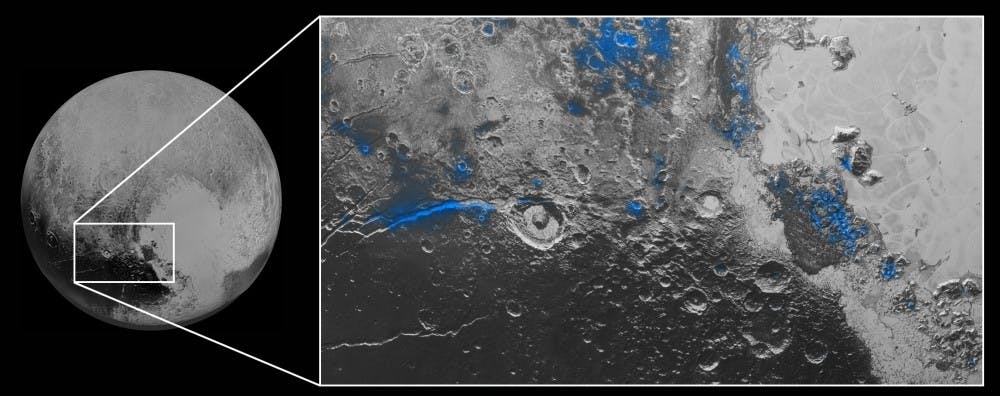By ELIZABETH LIU Senior Staff Writer
Pluto might not be as different from Earth as we had previously thought.
Pictures sent back from the New Horizons space probe, operated in part by researchers at the Johns Hopkins University Applied Physics Laboratory (APL), suggest that the little dwarf planet has vibrant cobalt skies and more exposed water ice than expected.
New Horizons is an integral part of NASA’s New Frontiers Program. The program includes three different missions: New Horizons, the mission to explore different celestial bodies at the edge of our solar system, including Kuiper Belt objects; Juno, a mission to Jupiter to better understand its origin and evolution; and OSIRIS-REx, the first mission ever that bring samples from asteroids to analyze on Earth.
New Horizons has been continuously sending back images of Pluto since the start of summer — researchers have been able to get a good look at Pluto’s glaciers, rusty red tundra and towering ice mountains.
However, all the pictures of the dwarf planet’s atmosphere were in black and white. In early October, the spacecraft finally sent back the first color images of Pluto’s atmosphere.
The photographs of the planet reveal that the atmospheric hazes are a striking cobalt blue hue.
The haze particles themselves are very likely a red or grey color, but when light from the sun hits them, they scatter the white light and result in blue visible light. The color of the scattered light can reveal a great deal about the size and composition of the particles; blue typically indicates that the particles are very small.

The effect, called Rayleigh scattering, is similar to the way that nitrogen molecules scatter light here in Earth’s atmosphere. Instead of nitrogen molecules, Pluto’s atmosphere contains soot-like molecules called tholins, complex organic solids found on quite a few celestial bodies in our solar system, such as the moons Triton and Titan.
These molecules are created when ultraviolet radiation from the sun breaks apart nitrogen and methane molecules in the highest layers of Pluto’s atmosphere. As the reddish-colored tholins drift down, they dust Pluto’s surface to give the dwarf planet its characteristic reddish-brown hue.
New Horizons has also discovered what seems to be a number of small exposed regions of water ice on the surface of Pluto. This discovery was made from data collected by the New Horizons’s Ralph spectral composition mapper. The researchers believe there is a lot more water ice obstructed from view by other more volatile substances such as methane ice, nitrogen ice and carbon monoxide ice. However, why certain sites show exposed water ice and others do not still remains a mystery.
Another strange aspect is that the areas that show the most obvious water ice spectral signals are some of the reddest parts of Pluto in the recently released color images. The scientists speculate that this could have something to do with how tholins react with water ice.
New Horizons is currently functioning normally, 3.1 billion miles away from Earth. The researchers are looking forward to more data and images from the spacecraft — all of it should be back on Earth by the end of 2016.





